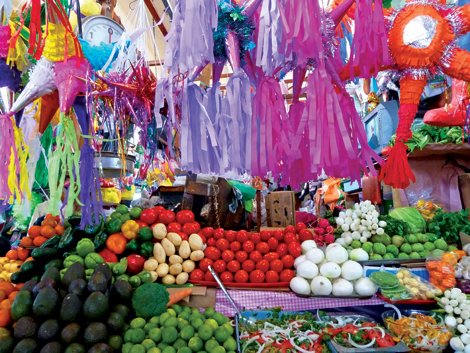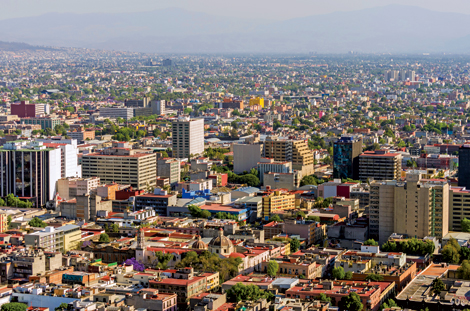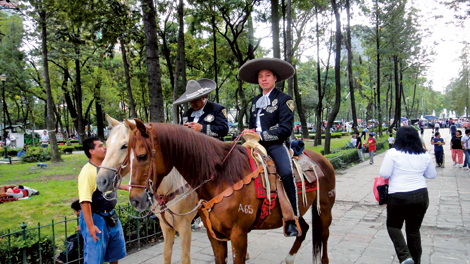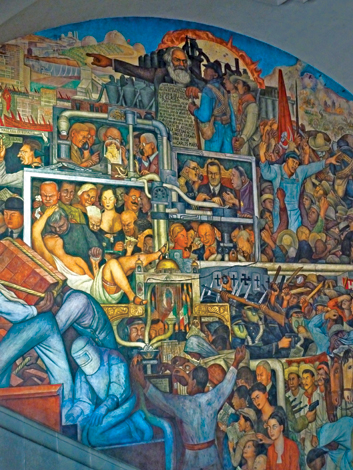Like a giant hand-painted comic book, the murals of 20th-century artist Diego Rivera cover every inch of the vast interior walls of the National Palace, depicting the history of Mexico in vivid technicolour.
Standing, neck craned, between the two staircases that lead to the upper walkway, you can see the story of the indigenous Mayans and Aztecs, the arrival of Spanish Conquistadors led by a grotesque Hernan Cortes in the 1500s, the cruelty of the Inquisition, the Mexican Civil War of 1910-20, and Karl Marx pointing in the direction of a utopian future, while gold-grabbing capitalists and corrupt, carousing priests carry on beneath him.
Since the founding of “New Spain”, now known as Mexico (it gained independence in 1821), the country has moved from a place of blood-thirsty sun-worshippers who conducted thousands of human sacrifices on pyramid altars, to an ambitious, forward-looking democracy of 120 million people.
It now has the second-largest economy in Latin America (just behind Brazil). It’s doing so well, in fact, that economist Jim O’Neill has identified it as one of four future economic giants – just as his so-called BRICs (Brazil, Russia, India and China) have emerged to become nations of booming wealth and progress, so the MINTs (Mexico, Indonesia, Nigeria and Turkey) are predicted to follow in their footsteps.

“If the MINTs reach their potential, they could change the world,” O’Neill said on a BBC Radio 4 programme in January. Why Mexico? For a start, president Enrique Pena Nieto, who was elected at the end of 2012, has been amending the constitution and pushing through radical new reforms that apply to almost every aspect of society – from education, tax and banking to telecommunications, financial services and energy. “It’s all aimed at boosting productivity, opening up the economy to foreign investment and readying the country for sustained growth”, as Pena Nieto said.
O’Neill said: “What is convincing about the ‘Mexico Moment’ is that it coincides with a remarkable shift in the world economy. For Mexico, things are happening on the supply and the demand side – just as they are enacting their reforms, they are finding that they can suddenly compete with the world’s biggest exporter.
“China has been deliberately boosting wages, as well as allowing the currency to rise, so suddenly any number of countries can find themselves in a position to compete, and none more so than Mexico.”
At the heart of it all is the capital, Mexico City, virtually equidistant from both the coastlines of the Gulf of Mexico and the Pacific Ocean, and from the US border to the north and Guatemala to the south. Jose Manuel Ramirez, partner in charge of international tax practice at KPMG in Mexico, says: “Historically, our culture has been very centralised. Looking back to the pre-Hispanic era to what is now Mexico City and the whole government for the Aztecs were based in Mexico City [formerly Tenochtitlan]. All the business and trade happened around there and that hasn’t changed for 500 years. There are now more than 150 multinationals in the capital.”
With nine million people (21 million in the greater metropolitan area) averaging a youthful age of 25, the city proper produces almost 22 per cent of the country’s GDP (US$1.8 trillion in 2013) and has been ranked by Pricewaterhouse Coopers among the top-ten richest cities in the world. This is a place, however, of shocking inequality, with more than 45.5 per cent of the country’s population living below the poverty line. You only have to drive past the huge shanty towns around the capital to see this is a major issue that needs to be resolved.

O’Neill said: “Economic growth is driven by two things – the working population and its productivity. And it seems, for the first time, that Mexico might have a pretty good chance of improving both. Crucially, its population is already young and expanding, the single-biggest factor for growth. And that is before you throw in those supply-side reforms – they are potentially a huge plus for productivity because they are meant to make it easier to get credit, to get connected, and to make that workforce even more open and flexible.”
Not everyone is happy, though, as so often is the case when change ripples through society. For several months at the end of last year, there were protests from teachers who set up a tented camp in Zocalo (Constitution Square) and blocked roads to the airport. On at least one occasion, there were violent clashes as police tried to disperse them with tear gas. Still, for a spectator, the reforms – which have since gone through – seem reasonable. Teaching positions can no longer be bought, or inherited by family members, and teachers will have to undergo systematic evaluations to ensure they are up to the job.
Another major reform is shaking up the energy industry. Mexico is the world’s sixth-largest producer of black gold, filling 2.5 million barrels a day, but until now its oil and gas reserves have been tapped exclusively by state-operated company Pemex. New legislation passed in December 2013 will see the industry privatised for the first time since 1938, resulting in projected revenues of US$10 billion a year in the form of royalties and taxes from outside investors, increased yield and cheaper energy prices.

Mexico’s undersecretary of hydrocarbons, Maria de Lourdes Melgar Palacios, was reported as saying: “We expect these reforms to result in an increase of one per cent to GDP by 2018 and an added 2.5 per cent of GDP by 2025.” Experts have forecast the associated value of direct and indirect investments to amount to US$1 trillion.
David Franco, principal analyst for Maplecroft, a risk analytics, research and strategic forecasting company, says: “With the help of private investment, oil production will, as in 2005, reach 3.5 million barrels a day in 2018.” The first contracts are expected to be awarded next year, with firms from China, Singapore, Europe and the Americas already showing an interest.
O’Neill said: “Energy reform is crucial to the future of Mexico. The Ku-Maloob-Zaap oil field on its own produces almost ten?per cent of what Saudia Arabia can muster.” But he noted that the reforms were “deeply controversial”.
“Resources like oil have often been seen as national treasures, not to be exploited by foreigners or subjected to the open market,” O’Neill said. “But the flip side of national control is that you end up with a nationalised energy giant like Pemex, unable to benefit from making commercial decisions, infantilised by the state’s parental control.”
He predicts that without energy reform, Mexico’s economy will only grow by 1.7 per cent; but with it, it could increase by 5.5 per cent. (To date, growth has not been as good as hoped – last year it was just 1.1 per cent, and this year, estimates have been downgraded from 3.9 per cent to 3 per cent.)
According to Pro Mexico Trade and Investment (promexico.gob.mx), Mexico is one of the most connected commercial players globally, a gateway to a potential market of more than one billion consumers and 60 per cent of the world’s GDP. Its location means it can easily move exports to both North and South America, giving it another advantage over China. It has 11 free trade agreements with more than 40 countries, including NAFTA (the North American Free Trade Agreement).
The EU is Mexico’s second-largest export market after the US, trading mainly in machinery, electrical goods, transport equipment and mineral products, and a free trade agreement between the two came into play in 2000. “We have had five trade missions in the past four months with about 130 companies,” says John Pearson, head of UK Trade and Investment in Mexico.
Last summer, meanwhile, Mexico shook hands with China, creating what’s become known as the “Tequila Agreement” because of the large volumes of the national drink (and pork) the Asian nation wants to import.

As Mexico continues to open up, so transport and infrastructure needs to cater to demand. Last year, Mexico City’s Benito Juarez International airport experienced record traffic of 29.5 million people, with 12 million foreign visitors spending time in the capital itself.
With numbers expected to rise further, the government has proposed a 5,000-hectare expansion with 70 aircraft gates to accommodate an extra 40 million people a year. An architectural competition has so far seen Zaha Hadid, Richard Rogers and Norman Foster among those shortlisted to design the building, the first phase of which could be completed in 2018. There has also been talk of opening a second runway at Toluca airport, 60km away.
The capital has more than 600 hotels equating to 50,000 rooms, and plenty of big-name brands such as Four Seasons, Hyatt Regency and Intercontinental. A 260-room Hilton was unveiled in the Santa Fe business district in April. Alan Duggan, vice-president of sales in Latin America for Starwood Hotels, which has seven properties in the city (including a Sheraton, Le Méridien, W and St Regis), says: “Mexico is crucial to our growth strategy and is our largest market in Latin America. Mexico City has the most hotels in the region, reflecting its maturity as a business and leisure destination.”
Frequent reports of ongoing cartel violence across the country can be off-putting, but Mexico City is less affected than places such as Juarez and Acapulco. It also has a high police presence, especially in busy public areas, where you can expect to come across armed troops with dogs and riot shields, and patrol cars with blue lights flashing. Even though FTI Consulting’s 2014 Latin American Security Index suggested that the country as a whole is among the top five most dangerous to do business in (along with Venezuela, Honduras, Guatemala and Haiti), a few sensible precautions will mean most travellers to the capital should not have a problem.
Nick Panes, managing director of risk consultancy Control Risks (Mexico), says: “As with many megacities, it suffers from crime issues in certain parts, but as a place to do business I think it is a progressive, open destination where the security risks are not insurmountable.
“For a business traveller, the primary risks are going to be around street crim and being in the wrong part of town at the wrong time. These issues can be mitigated by following some common-sense precautions, such as not taking taxis off the street, trying to maintain a low profile and avoiding obvious displays of wealth.”
What does the future look like? Maplecroft’s Franco says: “Corruption is a still a high-risk?in Mexico City but, in the long-term, we believe Mexico to be one of the fastest-growing economies, because of all the strengths that it has when weighed against the weaknesses.”
KPMG’s Ramirez predicts: “There will be more high-rise commercial space. There will be more sophistication, more efficiency and better transportation. You will see Mexico City evolving very close to cities such as New York or London.”








